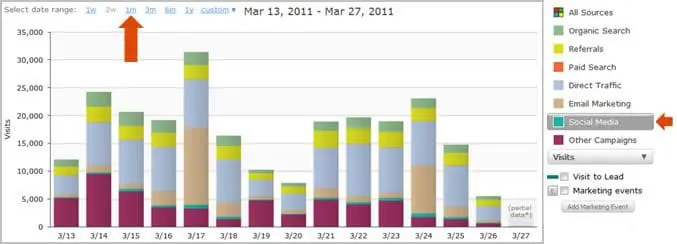 A few days ago I wrote about Measuring Social Media ROI. While this was a good overview, it left open the question of WHAT to measure.Bloggers and marketers talk about follower and fan counts, and retweet and comments. . . but an increasing fan count or retweets does not equal an ROI. These things are important to monitor, but how do they fit into your larger sales and marketing strategy? If you — or your boss — are starting to ask that question, it’s time to start analyzing more data points in your social media strategy and look at the bigger marketing picture. Here are 5 important data points to review when measuring social media ROI.
A few days ago I wrote about Measuring Social Media ROI. While this was a good overview, it left open the question of WHAT to measure.Bloggers and marketers talk about follower and fan counts, and retweet and comments. . . but an increasing fan count or retweets does not equal an ROI. These things are important to monitor, but how do they fit into your larger sales and marketing strategy? If you — or your boss — are starting to ask that question, it’s time to start analyzing more data points in your social media strategy and look at the bigger marketing picture. Here are 5 important data points to review when measuring social media ROI.
5 solid metrics of social media ROI
1) Measure social media networks together and separately. Each social media network has its own strengths. For example, you may find that Twitter drives the most website traffic, Facebook generates the most leads, and LinkedIn generates fewer, but more qualified, leads. Analyze your social media strategy in aggregate so you can compare it so other campaigns, but then break it down by network. This will let you determine which networks are helping you meet specific sales and marketing goals, and which networks might need a different approach to be more productive.
2) Track visitor-to-lead conversion. Website traffic alone doesn’t drive sales. You’ll want to track (network by network and as in aggregate) how many of those visitors convert into leads. Knowing exactly how much of a role social media plays in lead generation will help you meet your monthly lead goals and will provide historical data of lead growth month over month.
3) Track lead-to-customer conversion. This is the next logical step. Now make use of closed loop analytics to see how many of these leads turned into customers. Which networks actually drove traffic that converted into customers? This insight will help you implement a mature lead scoring system so your sales team can focus on the leads that are most likely to close. You can also create metrics like cost of acquisition for social media customers, and how much they spend compared to leads from other campaigns.
4) Score leads and monitor the sales cycle. Score your social media leads and monitor how much time it takes a social media lead to make it through the sales cycle. Not only does scoring leads help your sales team prioritize its time, but this insight will also inform your lead nurturing program so you can shorten the sales cycle for social media leads. It also helps you understand how valuable a social media lead is, and where it ranks compared to leads from other campaigns or marketing activities.
5) Watch site behaviors from your social media traffic. Understanding how to properly nurture social media leads will depend heavily on this step. Watch where social media leads enter, leave, and spend their time on your site, and you’ll see what type of content addresses their specifc needs. Then you can provide content that addresses their specific interests and problems.
Being able to tie actual dollars to the process of generating and converting leads from social media networks is critical to business success, and your success as a marketer. Tracking these data points gives you the ability to say whether social media activity really does drive sales and revenue.
What metrics do you use to evaluate the effectiveness of your social media strategy?





